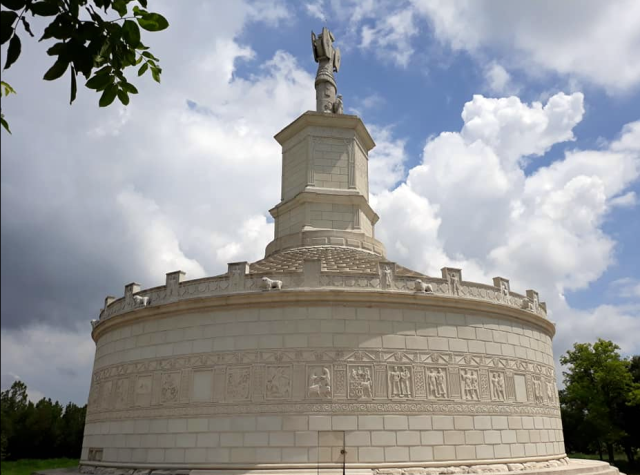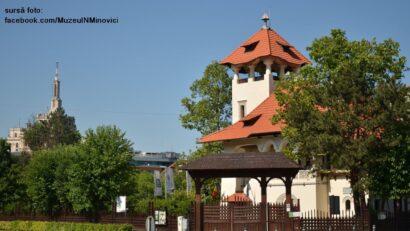Trajan’s Trophy
Trajans Trophy is a public monument built in Adamclisi, SE Romania, to honour Roman emperor Trajan.

Steliu Lambru, 15.03.2020, 14:00
Ancient Rome used to honour its
heroes by awarding them titles, holding public holidays and building monuments.
Trajan’s Trophy, or Tropaeum Traiani in Latin, was one such example of a public
monument built in Dobrogea, in south-eastern Romania, in the village of
Adamclisi. To honour emperor Trajan, the Roman Senate and people built an
impressive structure after the victory in the First Dacian war of 101-102.
Trajan’s Trophy is considered one of the biggest and most representative
ancient monuments in Romania. What we see today is in fact a reconstruction made
under the supervision of archaeologists and finalised in 1977. The first
excavations began in 1882, four years after Romania was awarded Dobrogea
following the Russian-Romanian-Turkish war of 1877-1878. Grigore Tocilescu, the
founder of the Romanian school of archaeology, was the man who initiated an
excavation and research campaign that would go on for the next 100 years.
The central monument consists of a
cylindrical base with a diameter of 40 metres and a number of circular steps. The
plinth is covered by a roof in the shape of a truncated cone with fish scale
ornaments, with a hexagonal structure standing in the middle of the plinth. On
top of the structure stands the trophy, namely a Roman soldier with four
shields, measuring 11 metres in height. At the base of the trophy are two
groups of statues featuring depictions of three Dacian prisoners. The height of
the entire monument is approximately equal to the diameter of the 40 m base.
The archaeologist Alexandru Barnea,
who coordinated some of the excavations carried out at the archaeological site in
Adamclisi has given us more details about the location of the monument:
The monument of Adamclisi forms
part of a complex of monuments located on top of the hill near the actual
village and is by far the most imposing and best known. Nearby there are two
other important monuments and the ruins of a city. A burial mound is found
nearby containing the tomb of an unidentified commander. A few hundred meters
further away lie the ruins of a funerary altar dedicated to those who died in
the battle that took place in these parts. The fighting between the Dacians and
the Romans occurred near the actual village, on the plateau where the monument
is located today, as well as in the surrounding area. This happened in the year
102 at the end of the so-called First Dacian War, when the Dacians tried to
attack the Romans in their own province.
The Roman presence in the Lower
Danube regions had been consolidated a century and a half earlier by the wars
between the Dacians and the Romans. The archaeologist Alexandru Barnea says the
province of Lower Moesia, the ancient name of Dobrogea, was an integral part of
Roman culture and civilisation:
Looking at a historical map we note
that Dobrogea was part of the Roman Empire, more precisely it was part of a
province of the empire called Lower Moesia. Roman organisation and
administration was already functioning in this province. In those dramatic
times for the Dacians, King Decebalus together with his Germanic allies
attacked the Romans on their own territory in the year 102 trying to cause a
diversion. Taken by surprise, the Romans suffered a lot of losses but resisted
and gradually recovered, and the reinforcements received helped them to defeat
Decebalus’ Dacian-Germanic alliance. After these battles, the Romans, emperor
Trajan himself in fact, decided to build a monument here in memory of those
tragic battles.
The whole ensemble of which the
monument forms part also contains a funerary altar whose walls are inscribed
with the names of the around 3,800 Roman soldiers who died in Adamclisi. There
is also a mausoleum with three concentric walls where the Roman commander was
buried who won the battle for the Romans in 102 by sacrificing his own life.
Archaeologist Alexandru Barnea about the different interpretations of the
monument:
The monument, which was built it
seems after designs by the famous architect Apollodorus of Damascus was
unveiled in the year 109. A few years later, in 113, when peace had arrived
both here in the Lower Danube area and in Dacia, which had by then become a
Roman province, Trajan’s Column was unveiled in Rome. The column together with
the monument of Adamclisi may be regarded as the ‘birth certificates’, one the
original and the other a duplicate, of the Romanian nation. Many historians see
the two monuments in this light. Speculations that the monument of Adamclisi
was rebuilt or built at a later date than first established and that it was a
reconstruction dating from the Constiantinian era were not supported by
research carried out in the 1980s. The research on this monument, the burial
mound and the funerary altar were completed a long time ago and there isn’t
much more to say in terms of the archaeological interpretation. There is
perhaps still room for artistic interpretation and even historical
interpretation of the depictions on the triumphal monument.
Adamclisi is also home to a Roman
citadel founded by emperor Trajan on the site of an old Geto-Dacian settlement.
A basilica maintained in situ adds to the remains dating back almost 2000
years.





























